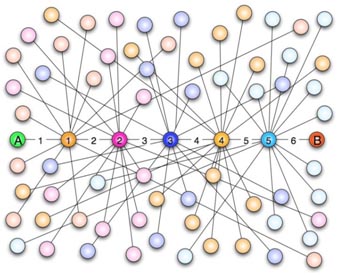数据结构 06-图3 六度空间 (30 分)
作者:互联网
“六度空间”理论又称作“六度分隔(Six Degrees of Separation)”理论。这个理论可以通俗地阐述为:“你和任何一个陌生人之间所间隔的人不会超过六个,也就是说,最多通过五个人你就能够认识任何一个陌生人。”如图1所示。

图1 六度空间示意图
“六度空间”理论虽然得到广泛的认同,并且正在得到越来越多的应用。但是数十年来,试图验证这个理论始终是许多社会学家努力追求的目标。然而由于历史的原因,这样的研究具有太大的局限性和困难。随着当代人的联络主要依赖于电话、短信、微信以及因特网上即时通信等工具,能够体现社交网络关系的一手数据已经逐渐使得“六度空间”理论的验证成为可能。
假如给你一个社交网络图,请你对每个节点计算符合“六度空间”理论的结点占结点总数的百分比。
输入格式:
输入第1行给出两个正整数,分别表示社交网络图的结点数N(1<N≤103,表示人数)、边数M(≤33×N,表示社交关系数)。随后的M行对应M条边,每行给出一对正整数,分别是该条边直接连通的两个结点的编号(节点从1到N编号)。
输出格式:
对每个结点输出与该结点距离不超过6的结点数占结点总数的百分比,精确到小数点后2位。每个结节点输出一行,格式为“结点编号:(空格)百分比%”。
输入样例:
10 9
1 2
2 3
3 4
4 5
5 6
6 7
7 8
8 9
9 10输出样例:
1: 70.00%
2: 80.00%
3: 90.00%
4: 100.00%
5: 100.00%
6: 100.00%
7: 100.00%
8: 90.00%
9: 80.00%
10: 70.00%'
测试点4为密集图,应该使用 邻接矩阵
邻接表写法 测试点4超时了
思路没什么问题 但是密集图不应该使用邻接表
#include <iostream>
#include <vector>
#include <map>
#include <math.h>
#include <iomanip>
using namespace std;
class arcNode{
public:
int data;
arcNode* next{nullptr};
arcNode()=default;
arcNode(int d):data{d}{};
};
class vertexNode{
public:
int data;
arcNode* first{nullptr};
vertexNode()=default;
vertexNode(int d):data{d}{};
};
class adjacencyListGraphic{
public:
map<int,vertexNode*> vertexs;
int arcNum{0},vertexNum{0};
adjacencyListGraphic()=default;
void BFSTraversal(){
map<vertexNode*,int> visited;
for(auto it=vertexs.begin();it!=vertexs.end();it++){
visited[vertexs[it->first]]=0;
}
for(auto it=vertexs.begin();it!=vertexs.end();it++){
map<vertexNode*,int> visitedTemp=visited;
cout.setf(ios::fixed);
cout << it->second->data <<": "<<setprecision(2)
<< BFS(vertexs[it->first],visitedTemp)*100<<"%"<<endl;
}
}
double BFS(vertexNode* vn,map<vertexNode*,int> &visited){
vertexNode* vnp=vn;
vector<vertexNode*> vertexnodes;
vector<vertexNode*> stack;
vector<arcNode*> arcNodes;
stack.push_back(vnp);
vertexnodes.push_back(vnp);
int count{0};
for(int i=0;i<=6;i++){
stack=vertexnodes;
vertexnodes.clear();
while(stack.size()){
if(!visited[stack.front()]){//顶点未访问过
visited[stack.front()]=1;//访问位置为true
arcNode* anp=stack.front()->first;//将边都推入
while(anp){
if(!visited[vertexs[anp->data]]){//边中包含未访问点 推入待访问队列
vertexnodes.push_back(vertexs[anp->data]);
}
anp=anp->next;
}
stack.erase(stack.begin());//边中未访问的顶点都推入队列后,删除顶点
}
}
}
count=0;
for(auto it=visited.begin();it!=visited.end();it++){
if(it->second){
count ++;
}
}
return double(count)/vertexNum;
}
void insertNode(int a,int b){//插入结点 插入边
if(vertexs.find(a)==vertexs.end()){//没有这个顶点 则建立顶点
vertexs[a]=new vertexNode{a};
vertexs[a]->first=new arcNode{b};
}else{//已经存在该顶点, 加入边表
arcNode* p=vertexs[a]->first;
while(p->next){//到边表末尾
p=p->next;
}
p->next=new arcNode{b};
}
}
void build(int n,int m){
vertexNum=n;
arcNum=m;
int a,b;
for(int i=0;i<m;i++){//建立无向图邻接表
scanf("%d %d",&a,&b);
insertNode(a, b);
insertNode(b, a);
}
}
};
int main(){
int n,m;
cin >> n >> m;
adjacencyListGraphic ALG;
ALG.build(n, m);
ALG.BFSTraversal();
return 0;
}
标签:结点,六度,06,int,vertexs,30,arcNode,visited,data 来源: https://www.cnblogs.com/ichiha/p/14797950.html